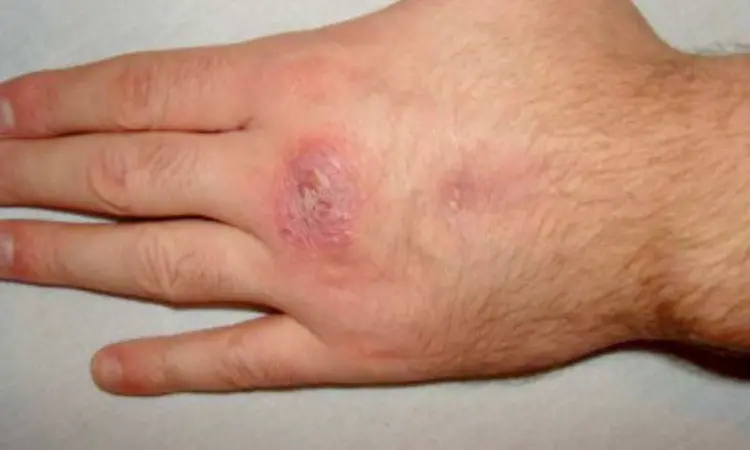- Home
- Medical news & Guidelines
- Anesthesiology
- Cardiology and CTVS
- Critical Care
- Dentistry
- Dermatology
- Diabetes and Endocrinology
- ENT
- Gastroenterology
- Medicine
- Nephrology
- Neurology
- Obstretics-Gynaecology
- Oncology
- Ophthalmology
- Orthopaedics
- Pediatrics-Neonatology
- Psychiatry
- Pulmonology
- Radiology
- Surgery
- Urology
- Laboratory Medicine
- Diet
- Nursing
- Paramedical
- Physiotherapy
- Health news
- Fact Check
- Bone Health Fact Check
- Brain Health Fact Check
- Cancer Related Fact Check
- Child Care Fact Check
- Dental and oral health fact check
- Diabetes and metabolic health fact check
- Diet and Nutrition Fact Check
- Eye and ENT Care Fact Check
- Fitness fact check
- Gut health fact check
- Heart health fact check
- Kidney health fact check
- Medical education fact check
- Men's health fact check
- Respiratory fact check
- Skin and hair care fact check
- Vaccine and Immunization fact check
- Women's health fact check
- AYUSH
- State News
- Andaman and Nicobar Islands
- Andhra Pradesh
- Arunachal Pradesh
- Assam
- Bihar
- Chandigarh
- Chattisgarh
- Dadra and Nagar Haveli
- Daman and Diu
- Delhi
- Goa
- Gujarat
- Haryana
- Himachal Pradesh
- Jammu & Kashmir
- Jharkhand
- Karnataka
- Kerala
- Ladakh
- Lakshadweep
- Madhya Pradesh
- Maharashtra
- Manipur
- Meghalaya
- Mizoram
- Nagaland
- Odisha
- Puducherry
- Punjab
- Rajasthan
- Sikkim
- Tamil Nadu
- Telangana
- Tripura
- Uttar Pradesh
- Uttrakhand
- West Bengal
- Medical Education
- Industry
Treatment with JAK inhibitor for myelofibrosis leads to Mycobacterium marinum skin infection: A case report

China: A recent article published in Clinical, Cosmetic and Investigational Dermatology reports the case of mycobacterium marinum skin infection in the left upper limb of a female patient with chronic idiopathic myelofibrosis during ruxolitinib treatment.
"Our case illustrates the diversity of skin infections that may occur during JAK (Janus kinase) inhibitors treatment, and the need for clinical attention to atypical mycobacterial skin infections cannot be ignored," Xiaonan Chen, Affiliated Hospital of Weifang Medical University, Weifang, People's Republic of China, and colleagues wrote in their case study.
Mycobacterium marinum is an atypical bacterium, and skin infections that result from it are relatively rare, usually occurring in homemakers who clean and prepare fish for food and workers engaged in seafood processing. The infection often occurs after fish spines, scales, etc., puncture the skin. The JAK/STAT signalling pathway is closely linked with the human immune response to infections. Therefore, JAK inhibitors may induce and exacerbate various conditions in clinical practice.
The JAK inhibitors have received approval from the US Food and Drug Administration (FDA) for treating various diseases such as atopic dermatitis, rheumatoid arthritis, and myelofibrosis. However, they are reported to lead to severe adverse reactions such as tumours, infection, and thrombosis, and thus have been given a black box warning by the FDA. Still, no literature has reported on mycobacterium marinum skin infections occurring during JAK inhibitor treatment, which is relatively rare.
The case concerns a 56-year-old female who came to seek medical attention due to the appearance of nodules and patches on her forearm and left thumb for the past 1.5 months. There appeared to be no apparent trigger before the onset. A red nodule the size of a soybean appeared on the left thumb. Treatment was initiated with polymyxin B ointment (containing polymyxin B and lidocaine, etc.) for two weeks, but the skin lesion increased. Two red infiltrative patches appeared on the skin of the left forearm one month prior.
The patient denied being scratched or punctured by fish spines or scales. Clinical manifestations included multiple infiltrative erythemas and subcutaneous nodules in the forearm and the thumb. Histopathological examination revealed infiltration of mixed acute and chronic inflammatory cells in the subcutaneous tissue. NGS sequencing ultimately confirmed the diagnosis. The patient was cured after taking clarithromycin and moxifloxacin for ten months.
Chen and the team suggest that healthcare providers should be aware of the possibility of various infections, including skin infections, in patients using JAK inhibitors. They also offer considering atypical mycobacterial and common viral infections such as herpes zoster.
"NGS sequencing has great value in identifying the causative pathogen of the infection," they wrote. "Discontinuing JAK inhibitors and undergoing long-term, standardized antibiotic treatment can result in recovery."
Reference:
Chen X, Zhang D, Wang T, Ma W. Ruxolitinib Treatment During Myelofibrosis Leads to Cutaneous Mycobacterium marinum Infection: A Case Report. Clin Cosmet Investig Dermatol. 2023;16:1499-1503 https://doi.org/10.2147/CCID.S413592
Dr Kamal Kant Kohli-MBBS, DTCD- a chest specialist with more than 30 years of practice and a flair for writing clinical articles, Dr Kamal Kant Kohli joined Medical Dialogues as a Chief Editor of Medical News. Besides writing articles, as an editor, he proofreads and verifies all the medical content published on Medical Dialogues including those coming from journals, studies,medical conferences,guidelines etc. Email: drkohli@medicaldialogues.in. Contact no. 011-43720751


